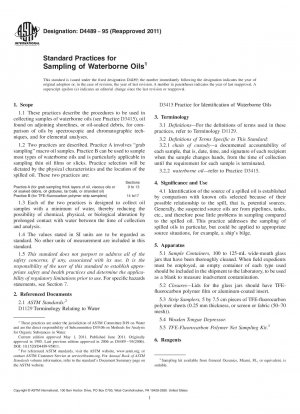ASTM D4489-95(2011)
Standard Practices for Sampling of Waterborne Oils
- Standard No.
- ASTM D4489-95(2011)
- Release Date
- 1995
- Published By
- American Society for Testing and Materials (ASTM)
- Status
- Replace By
- ASTM D4489-95(2017)
- Latest
- ASTM D4489-95(2017)
- Scope
Identification of the source of a spilled oil is established by comparison with known oils selected because of their possible relationship to the spill, that is, potential sources. Generally, the suspected source oils are from pipelines, tanks, etc., and therefore pose little problems in sampling compared to the spilled oil. This practice addresses the sampling of spilled oils in particular, but could be applied to appropriate source situations, for example, a ship's bilge.
1.1 These practices describe the procedures to be used in collecting samples of waterborne oils (see Practice D3415), oil found on adjoining shorelines, or oil-soaked debris, for comparison of oils by spectroscopic and chromatographic techniques, and for elemental analyses.
1.2 Two practices are described. Practice A involves “grab sampling” macro oil samples. Practice B can be used to sample most types of waterborne oils and is particularly applicable in sampling thin oil films or slicks. Practice selection will be dictated by the physical characteristics and the location of the spilled oil. These two practices are:
ASTM D4489-95(2011) Referenced Document
- ASTM D1129 Standard Terminology Relating to Water*, 1999-04-19 Update
- ASTM D3415 Standard Practice for Identification of Waterborne Oils*, 2017-12-15 Update
ASTM D4489-95(2011) history
- 2017 ASTM D4489-95(2017) Standard Practices for Sampling of Waterborne Oils
- 1995 ASTM D4489-95(2011) Standard Practices for Sampling of Waterborne Oils
- 1995 ASTM D4489-95(2006) Standard Practices for Sampling of Waterborne Oils
- 1995 ASTM D4489-95(2001) Standard Practices for Sampling of Waterborne Oils
- 1995 ASTM D4489-95 Standard Practices for Sampling of Waterborne Oils
